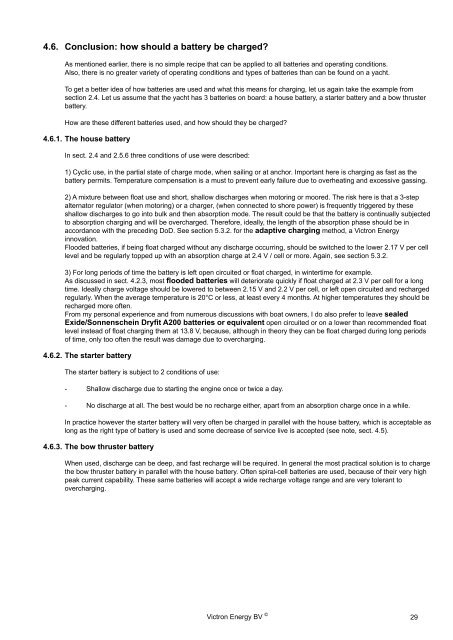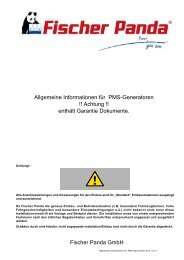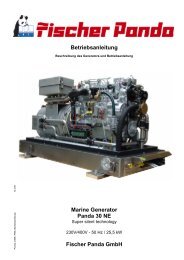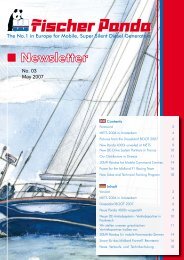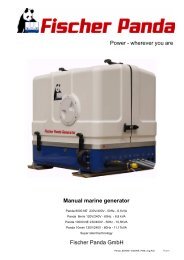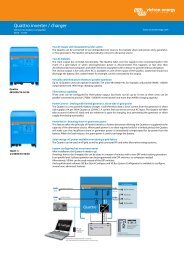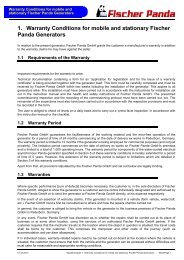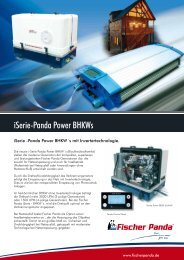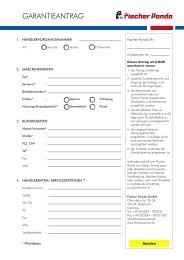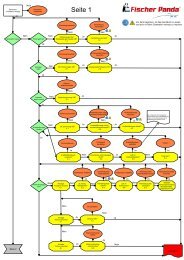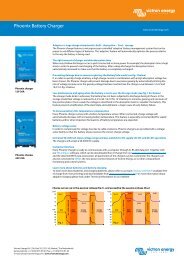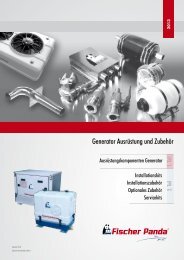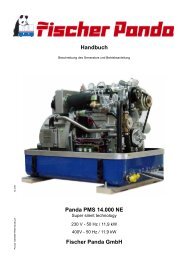Victron "Energy Unlimited" - Utu
Victron "Energy Unlimited" - Utu
Victron "Energy Unlimited" - Utu
You also want an ePaper? Increase the reach of your titles
YUMPU automatically turns print PDFs into web optimized ePapers that Google loves.
4.6. Conclusion: how should a battery be charged<br />
As mentioned earlier, there is no simple recipe that can be applied to all batteries and operating conditions.<br />
Also, there is no greater variety of operating conditions and types of batteries than can be found on a yacht.<br />
To get a better idea of how batteries are used and what this means for charging, let us again take the example from<br />
section 2.4. Let us assume that the yacht has 3 batteries on board: a house battery, a starter battery and a bow thruster<br />
battery.<br />
How are these different batteries used, and how should they be charged<br />
4.6.1. The house battery<br />
In sect. 2.4 and 2.5.6 three conditions of use were described:<br />
1) Cyclic use, in the partial state of charge mode, when sailing or at anchor. Important here is charging as fast as the<br />
battery permits. Temperature compensation is a must to prevent early failure due to overheating and excessive gassing.<br />
2) A mixture between float use and short, shallow discharges when motoring or moored. The risk here is that a 3-step<br />
alternator regulator (when motoring) or a charger, (when connected to shore power) is frequently triggered by these<br />
shallow discharges to go into bulk and then absorption mode. The result could be that the battery is continually subjected<br />
to absorption charging and will be overcharged. Therefore, ideally, the length of the absorption phase should be in<br />
accordance with the preceding DoD. See section 5.3.2. for the adaptive charging method, a <strong>Victron</strong> <strong>Energy</strong><br />
innovation.<br />
Flooded batteries, if being float charged without any discharge occurring, should be switched to the lower 2.17 V per cell<br />
level and be regularly topped up with an absorption charge at 2.4 V / cell or more. Again, see section 5.3.2.<br />
3) For long periods of time the battery is left open circuited or float charged, in wintertime for example.<br />
As discussed in sect. 4.2.3, most flooded batteries will deteriorate quickly if float charged at 2.3 V per cell for a long<br />
time. Ideally charge voltage should be lowered to between 2.15 V and 2.2 V per cell, or left open circuited and recharged<br />
regularly. When the average temperature is 20°C or less, at least every 4 months. At higher temperatures they should be<br />
recharged more often.<br />
From my personal experience and from numerous discussions with boat owners, I do also prefer to leave sealed<br />
Exide/Sonnenschein Dryfit A200 batteries or equivalent open circuited or on a lower than recommended float<br />
level instead of float charging them at 13.8 V, because, although in theory they can be float charged during long periods<br />
of time, only too often the result was damage due to overcharging.<br />
4.6.2. The starter battery<br />
The starter battery is subject to 2 conditions of use:<br />
- Shallow discharge due to starting the engine once or twice a day.<br />
- No discharge at all. The best would be no recharge either, apart from an absorption charge once in a while.<br />
In practice however the starter battery will very often be charged in parallel with the house battery, which is acceptable as<br />
long as the right type of battery is used and some decrease of service live is accepted (see note, sect. 4.5).<br />
4.6.3. The bow thruster battery<br />
When used, discharge can be deep, and fast recharge will be required. In general the most practical solution is to charge<br />
the bow thruster battery in parallel with the house battery. Often spiral-cell batteries are used, because of their very high<br />
peak current capability. These same batteries will accept a wide recharge voltage range and are very tolerant to<br />
overcharging.<br />
<strong>Victron</strong> <strong>Energy</strong> BV ©<br />
29


